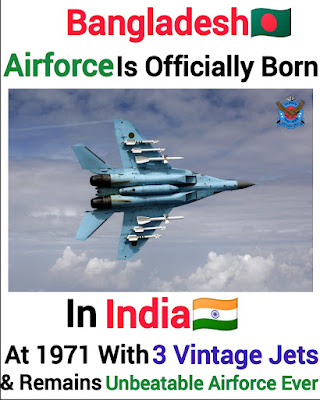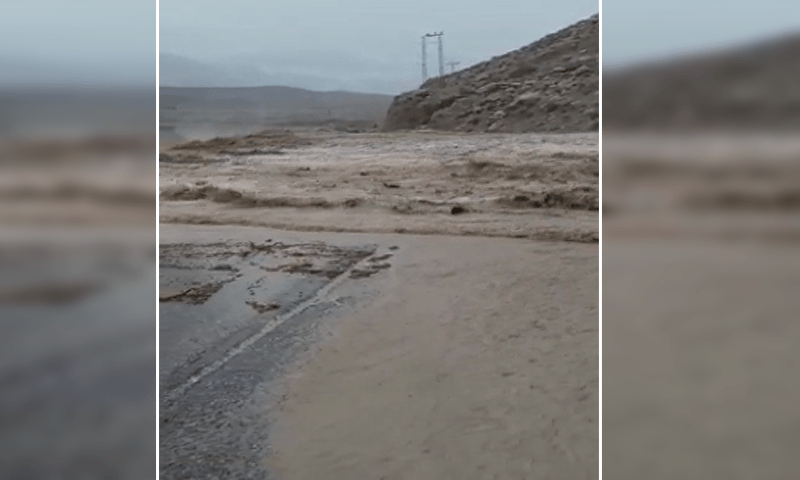The Bangladesh Air Force was officially formed in india
The Bangladesh Air Force was officially formed on 28 September 1971 consisting of the revolting Bengali officers and airmen of the Pakistan Air Force at Dimapur Airport in the Indian state of Nagaland[8] and it was launched formally by flying three repaired vintage aircraft on 8 October 1971.
BAF's initial personnel were around a 1000 Bengali members of the Pakistan Air Force who were stationed in East Pakistan at the outbreak of the war and who deserted to the Bangladeshi side.[9] At that time, the embryo of Bangladesh Air Force BAF was formed with less than a hundred officers and around 900 airmen and warrant officers. These numbers were gradually strengthened by the slow but steady defection from among the around 3000 Bengali officers and airmen stationed and grounded in West Pakistan. By the first week of December a total of 700 Bengali officers and airmen had defected from the Western border. A significant number of BAF personnel participated in the Ground Warfare roles in the Bangladesh War of Independence. During the independence war, initially, officers of the BAF attached to the then Bangladesh Government were Chief Representative to Chakulia Guerrilla Training Camp Squadron Leader M. Hamidullah Khan, Group Captain A. K. Khandekar, DCOS Army(Liaison) later Sub-Sector Commander and as Commander - Sector 11, Flight Lieutenant Liaqat as Battalion Adjutant, Flying Officer Rouf, Flying Officer Ashraf and Flight Sergeant Shafiqullah as company commanders. Squadron Leader Sadruddin Hossain, Squadron Leader Wahidur Rahim, Squadron Leader Nurul Qader, Squadron Leader Shamsur Rahman and Squadron Leader Ataur Rahman as sub sector company commanders. Squadron Leader Khademul Bashar participated in the war as Commander-Sector 6.
Indian civilian authorities and the IAF donated 1 DC-3 Dakota (gifted by the Maharaja of Jodhpor), 1 Twin Otter plane, and 1 Alouette III helicopter for the newborn Bangladesh Air Force.[11][8] The Bengali rank and file fixed up the World War II vintage runway at Dimapur Airport, then began rigging the aircraft for combat duty. The Dakota was modified to carry 500 pound bombs, but for technical reasons it was only used to ferry Bangladesh government personnel. The Alouette III helicopter was rigged to fire 14 rockets from pylons attached to its side and had .303 Browning machine guns installed, in addition to having 1-inch (25 mm) steel plate welded to its floor for extra protection. The Twin Otter boasted 7 rockets under each of its wings and could deliver ten 25 pound bombs, which were rolled out of the aircraft by hand through a makeshift door. This tiny force was dubbed Kilo Flight, the first fighting formation of the nascent Bangladesh Air force. Squadron Leader Sultan Mahmud was appointed as the commander of the 'Kilo Flight'.
Bangladesh Air Force first went in action on 3 December 1971 and attacked the Chattogram-based Oil tank depot and oil tank depot was totally destroyed by that air attack. The Air attack was conducted by Capt. Akram Ahmed.[14] The second Bangladesh Air Force attack was on 6 December 1971 at Moulvibazar Pakistani Army barracks under the command of Squadron Leader Sultan Mahmud, where Captain Shahabuddin Ahmed was co-pilot.
After the surrender of Pakistan, all personnel reported to Bangladesh Forces commander-in-chief, Col. M. A. G. Osmani. On 7 April 1972, the post of the chief of air staff went into effect by order of the President of Bangladesh. The combined command of Bangladesh Forces had been abolished with effect from 7 April 1972 and replaced by three separate commands for the three services with acting chiefs of staff. The Bangladesh air force gradually began to reoccupy the reform all the airbase structures throughout the country, HQ administrative buildings, fuel and weapons depots



Comments
Post a Comment